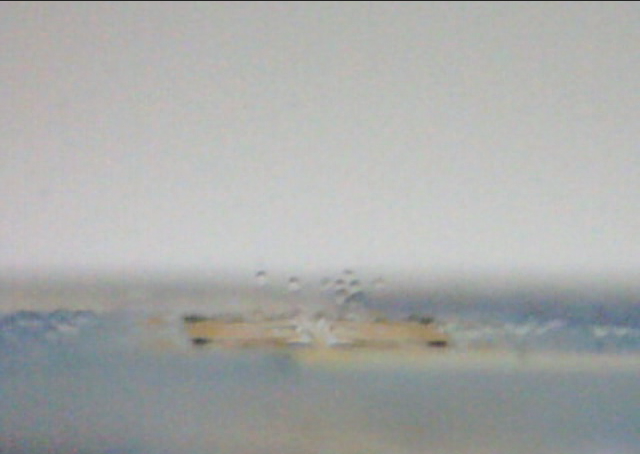細胞研究整合晶片
自從2003以來我們致力於新流體元件的研發。我們研究的目標是利用流體機制來抓取細胞。研究中發現利用磁場和電流產生的力(羅倫茲力)可以用來激發微小平板橫向振動,進而在流體中產生特殊的流場,我們稱它為對轉渦流。此對轉渦流不但可以用來抓取細胞更可以應用在增加流體的混合效率。目前研究目標嘗試將兩種元件整合在同一晶片裡,成為一可獨立操作的細胞研究晶片。預計未來可以應用此晶片做生物細胞與蛋白質的分離、DNA與蛋白質收集、初期癌症藥物測試、細胞培養...等多功能用途。
微懸浮顆粒抓取與鉗制
Trapping of suspended cells is fundamentally important for cellular studies. Some have utilized hydrodynamic approaches, particularly vortical flow. This work presents an entirely new device leveraging on a pair of counter-rotating micro-vortices to trap bio-particles. In contrast to other approaches, this device allows bioparticles to flow freely through unobstructed region, trapped, and controlled released. The authors believe this to be the first account of having these features.
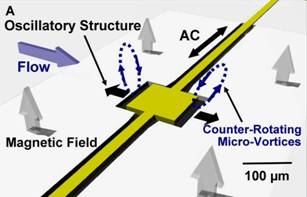 Figure 1. Sketch of the device. (A) The suspended thin (1μm thick) square plate (100μm*100μm) in resonance (140kHz.) induced a pair counter-rotating micro-vortices at plate edges. The total length of the suspended beam is 750μm and the width is 20μm. (B) Edge-on view of the oscillatory structure.
Figure 1. Sketch of the device. (A) The suspended thin (1μm thick) square plate (100μm*100μm) in resonance (140kHz.) induced a pair counter-rotating micro-vortices at plate edges. The total length of the suspended beam is 750μm and the width is 20μm. (B) Edge-on view of the oscillatory structure.
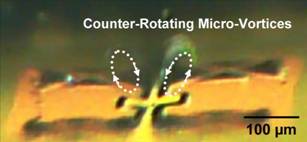 Figure 2. Micrograph of counter-rotating micro-vortices above the two-edges of the structure at resonant (140 kHz) at an instant in time. Trapped particles in the right vortex is evident. Left vortex also trapped particles as clearly seem in the movie. (Dotted lines are to guide the eyes.)
Figure 2. Micrograph of counter-rotating micro-vortices above the two-edges of the structure at resonant (140 kHz) at an instant in time. Trapped particles in the right vortex is evident. Left vortex also trapped particles as clearly seem in the movie. (Dotted lines are to guide the eyes.)
流體晶片
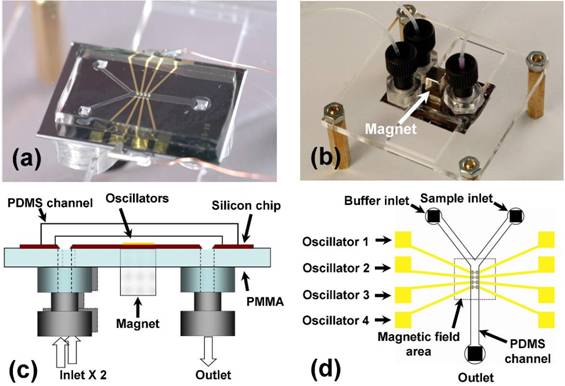
Figure 3. Microfluidic device. (a) There are four oscillators in a silicon chip (28mm*20mm) bonded in-between a PDMS channel and PMMA substrate (50mm*50 mm). Two wires were clipped to the metal pad for electric connection to the oscillators. (b) Device was upside down with tubing. A permanent magnet was placed right above the oscillator pierced through the PMMA substrate. (c) Schematic of device in cross-section. (d) A schematic of the microchannel with the four oscillators. The trapping region was in the middle of the channel and above the magnetic-field area marked by gray dotted line.
生物分子的抓取
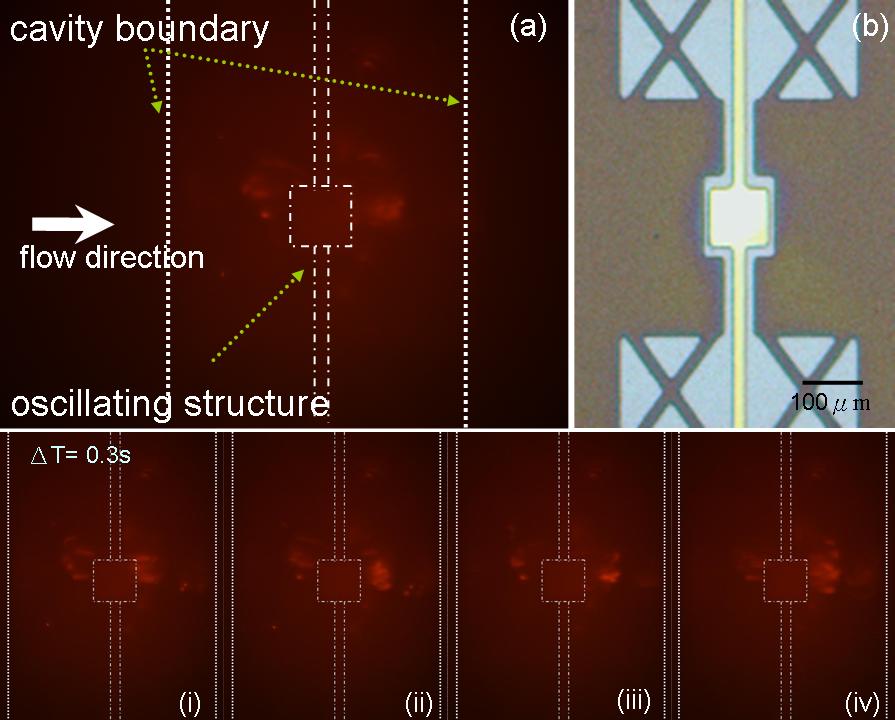
Figure 4 . (a) Shows the flow carrying proteins marked with fluorescent dye; proteins were trapped by vortices induced by the micro oscillating structure. (b) Top view from optical microscope. (i)~(iv) shows proteins were trapped and rotating above the oscillating structure at a time step, Δt = 0.3 second.
抓取實驗
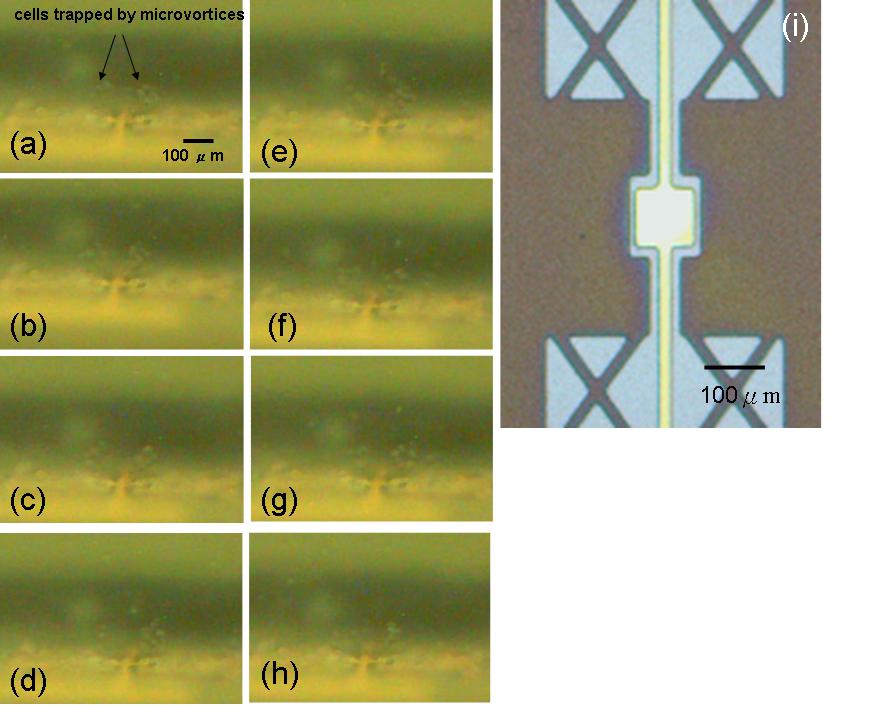
Figure 5. (a)~(h) show that CHO cells trapped and rotating above the oscillating structure at a time step, Δt = 0.5 second
HEK-Cells Trapping Experiment
細胞存活測試
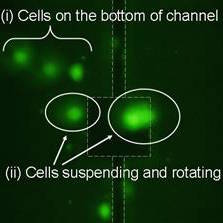
Figure 6. The cell viability of trapped HEK cells at 30min. (at 3Vpp, perfused at 20μm/s) Calcein AM was injected into channel for viability assay while cells trapped after 30min. White dash lines show the suspended plate. In upper left region (i), there are three bright green fluorescent marked cells are adhered on the bottom of channel. Clusters of HEK, in region (ii), cells rotating and trapped by the CRMV, there is no obvious difference between those two groups of cells. All of them were stained positively with calcein AM which demonstrates cells, in (b), are alive after continuous trapped by CRMV.
高效率微混合器


Figure 7. Mixer tested with 0.9μm fluorescent particles under an inverted microscope. (a) no signal was applied to the electrode, with the boundary of two flows evident. In (b) a sinusoidal signal of 90 kHz and 10Vp-p resulted in micro-vortices of Fig. 2. The thin plate and channel are denoted by dash line. (middle plate is 100μm by 200μm)
相關研究成果
- 第四屆上銀科技台灣機械碩士論文獎 優等獎
- 台灣與美國專利
國際SCI期刊
- Cheng Ming Lin, Yu Shang Lai, Hsin Ping Liu, Andrew M. Wo*, “Microvortices and Recirculating Flow Generated by an Oscillatory Microplate for Microfluidic Applications” Applied Physics Letters, Vol. 93, Issue 13, 133503, 2008. (SCI 3.596)
- Cheng Ming Lin, Yu Shang Lai, Hsin Ping Liu, Chang Yu Chen, and Andrew M. Wo*, “Trapping of Bioparticles via Microvortices in a Microfluidic Device for Bioassay Applications,” Analytical Chemistry, 2008. (in press, SCI 5.287)
研討會論文
- C. M. Lin, Y. S. Lai, H. P. Liu, and A. M. Wo, 2007 "Cell Trapping via Counter-Rotating Micro-Vortices," in The 11th International Conference on Miniaturized Systems for Chemistry and Life Sciences (MicroTAS) Paris, France.
- C. M. Lin, Y. S. Lai, H. P. Liu, and A. M. Wo, 2007 "Integration of a Micromixer and Tweezers for Cells and Bio-molecules Assay in a Microchannel," in IEEE-NANOMED Macau.
- H. P. Lui, C. M. Lin, Y. S. Lai, and A. M. Wo, 2008 "Mixing in a microfluidic device via rotating flow," in Nano and Micro Heat Transfer Tainan, Taiwan.
- C. M. Lin, C. C. Tseng, C. L. Chen, and A. M. Wo, 2009 "Hydrodynamic single-cell Trapping for celluar assays," in Transducers Denver, USA.
- C. M. Lin, C. C. Tseng, C. L. Chen, and A. M. Wo, 2009 "Hydrodynamic well for single-cell trapping in a microfluidic device," in The 13th International Conference on Miniaturized Systems for Chemistry and Life Sciences (MicroTAS) Jeju, Korea.
